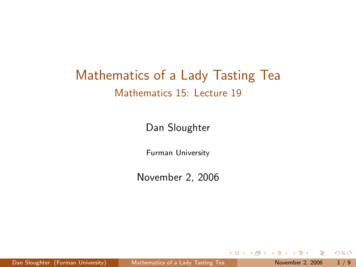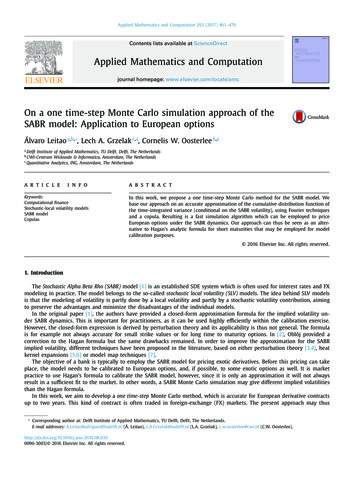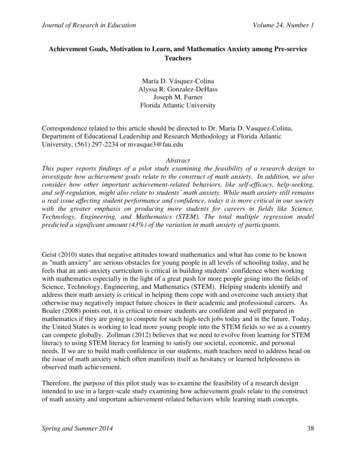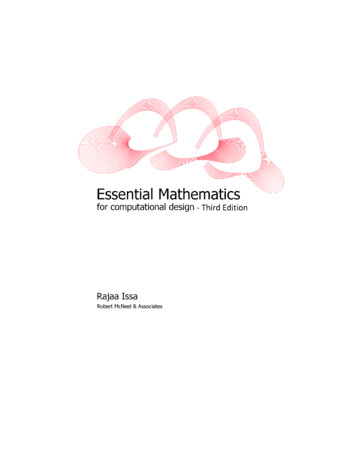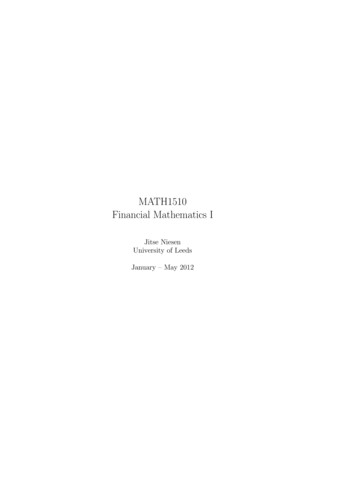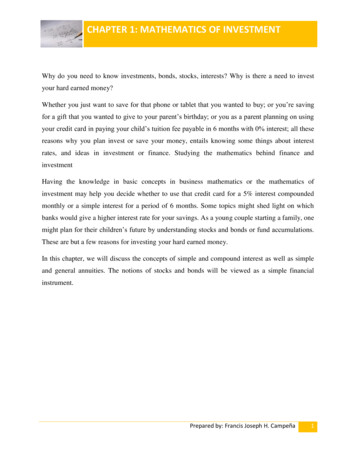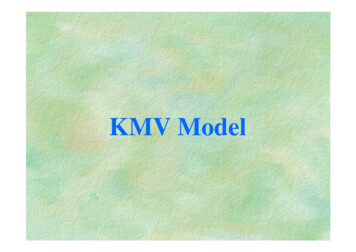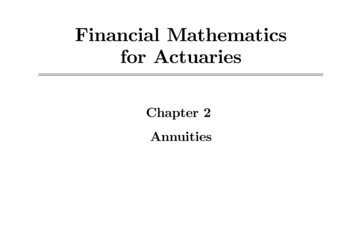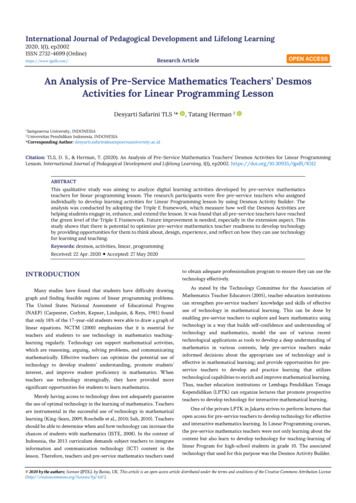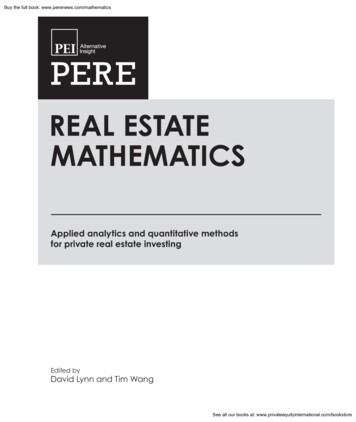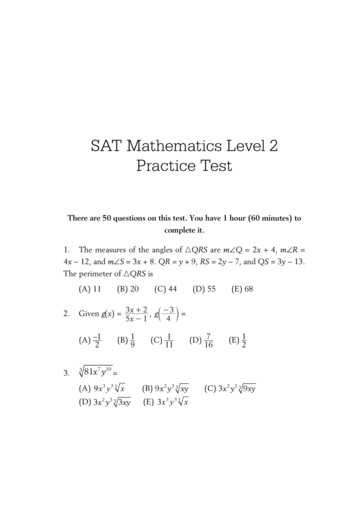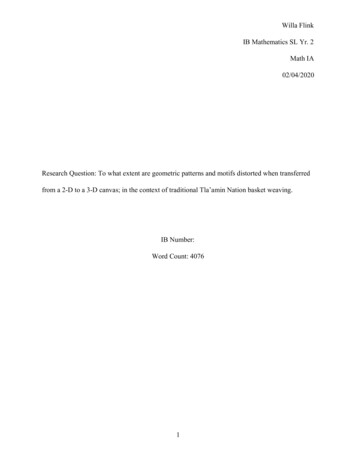
Transcription
Willa FlinkIB Mathematics SL Yr. 2Math IA02/04/2020Research Question: To what extent are geometric patterns and motifs distorted when transferredfrom a 2-D to a 3-D canvas; in the context of traditional Tla’amin Nation basket weaving.IB Number:Word Count: 40761
Research Question: To what extent are geometric patterns and motifs distorted when transferredfrom a 2-D to a 3-D canvas; in the context of traditional Tla’amin Nation basket weaving.Introduction:The Tla’amin Nation of the Canadian Northwest has a rich history of basket weaving.Abstract, realistic, simple and complex patterns are passed down to the next generation ofTla’amin children along with the skills and techniques required to weave them into reality.Living on land of the Dakota people in Minneapolis Minnesota and browsing for summer readsat my neighborhood bookstore Birchbark Books owned by the Ojibwe author Louis Erdrich, Iam surrounded by Native art, culture and history. Some stories of this history were told at theMinneapolis Institute of Arts’ (Mia) exhibit- Hearts of Our People: Native Women Artists - that Iattended, where the works of Native craftswomen in a myriad of mediums were displayed. Theworks I was most impressed by were the woven baskets made from grasses, barks and manyother materials. I take an AP Studio Art course at school where we experiment with patterndesign and tessellation in paper cutting and printmaking. Seeing intricate geometric patterns withperfect symmetry reflected and rotated on circular and rectangular 3-D basket “canvases” wasamazing. When I considered the lack of digital weaving machines, exact measuring tools and theuse of purely natural materials when the exhibited baskets were woven a hundred years agomade them even more extraordinary. I also was impressed by the fact that the patterns’ scale andpositionsing on each basket looked extremely intentional even though transferring a pattern froma 2-D concept design (planned out on paper for example) to a 3-D surface can often result in2
some unintended distortion. The motifs on the baskets were at times purely geometric but alsoechoed the forms of plants and animals in a limited number of dyed colors and weaving styles.After seeing how identically these patterns were replicated over and over on baskets, I wonderedhow indigenous people could have possibly executed them without using geometry? The answeris they could not have. Though Native crafts like basketry have never been incorporated into mygeometry curriculum at school as a life-based, applied mathematical teaching tool, indigenousweavers were and are master geometers who use geometry just as legitimate and relevant asPythagoras did. In the following essay I will be exploring the enduring tradition of Tla’aminbasket weaving, the Nation’s collaboration with Simon Fraser University (SFU) and its MathCatcher Outreach Program and the online Callysto program, as well as the extent to whichTla’amin basket motifs are distorted during transfer from a 2-D to a 3-D canvas using Jupyternotebooks.Exploration:In the following exploration, I will be diving into the history of basketry in the Tla’aminNation, the Tla’amin people’s partnership with SFU and the Callysto program and the innerworkings of Jupyter Notebooks.Firstly, the emblem of the Tla’amin Nation is pictured below:3
(Tla'amin Nation, "Culture", p. 1)Tla’amin basketmakers have joined and tessellated multiple simple motifs to create complex andrealistic patterns for generations. Children of each generation are taught weaving techniques tokeep the art form alive. Below are examples of Tla’amin basket weaving in action and thepractice being taught to children:(Tla'amin Nation, "Culture", p. 1)4
(Tla'amin Nation, "Culture", p. 1)The Tla’amin people live on land in the Canadian Northwest. In that region, Cedar trees areabundant and therefore are central to Tla’amin culture and more specifically, Tla’amin baskets.During the basket-making process, “skilled gatherers will strip sections of bark of a cedar treeand harvest suitable cedar roots with great care being taken not to harm the tree or take excess.These are then prepared into strips used for weaving baskets” (Tla'amin Nation, "Culture", p.1). By sustainably gathering basket supplies, the weavers and Cedar trees exist symbiotically. Asimilar relationship is maintained between Ojibwe basket makers in my home state of Minnesotawith Birch trees so that Birchbark is not harvested to excess. In addition to Cedar bark beingutilized by basket weavers of the Tla’amin Nation, geometry is also heavily utilized. The basketsare “examples of functional mathematics and art. Baskets of all shapes and sizes are built withthe purpose of packing food, storing goods or even as baby cribs. Building a basket is a smallbio-engineering project that requires mathematical thinking and math-related skills. These skillsinclude precise measurement, the creation of appropriate shapes and adhering to certainwell-established patterns.” (Jungic, "Indigenous basket-weaving makes an excellent digital mathlesson", 2020, p. 1). By understanding the geometry of pattern transformation, Tla’amin master5
basketeers are able to achieve almost flawless symmetry in their baskets like what I witnessedand was so impressed by at the Mia’s Native Women Arts exhibit. Below are two examples ofthe symmetry of the Tla’amin tesselated basket patterns:(Callysto, "Welcome to Callysto!", 2007-2017, p. 1)Despite the fact that math plays such a large role in Tla’amin basket weaving and by extensionNorth American indigenous basketry as whole, lessons regarding the mathematical elements ofbasket weaving are rarely taught in school math curriculums. Even in schools with apredominantly Native student body, the story of the connection between Native arts, crafts andmath is rarely told. Without acknowledgement of the mathematical significance of Native arts,both Native and non-Native students will believe math used and generated by indigenous peoplesis nonexistent and irrelevant. This belief was something Principal Pat Seltzer of thepredominantly Navajo highschool of Monument Valley was faced with. Seltzer said: ‘“We havea hard time motivating kids here because something like geometry has no relevance to them,’”she says. ‘“You don't really learn unless you're putting the information in your own terms, yourown perspective.”’ (Hope, "Math in Indigenous Weaving - An Overview", 2004, p. 1). Navajostudents at Seltzer’s school were being taught an Anglicized, linear curriculum that omitted allexamples of existent Native applied mathematics (Hope, "Math in Indigenous Weaving - AnOverview", 2004, p. 1). In response to the void that is Native culture in math curriculums, Simon6
Fraser University’s (SFU) Professors Veselin Jungic, Cedric Chauve and a group of SFUgraduate students partnered with leaders of the Tla’amin Nation and an online interactive graphiccoding program called Callysto, to create an online platform where Canadian students and artistscan digitally weave baskets. This partnership was fully approved by the Tla’amin community’sleader Hegus Clint Williams. Below are pictured the people who inspired the project, ProfessorVeselin Jungic and Betty Wilson of the Tla’amin Nation:(Pacific Institute & Mathematical Sciences, "Weaving A New Future For Indigenous Education",2019, p. 1)Using Callysto and its online program Jupyter Notebooks, “Profs Jungic and Chauve set out tocreate content that teaches basic geometric math concepts based on the intricate weaving ofIndigenous basket patterns.” (Pacific Institute & Mathematical Sciences, "Weaving A NewFuture For Indigenous Education", 2019, p. 1). The professors created two notebooks, oneentitled Atomic Motifs and another, Combining and Editing Motifs to create 3D Basket Models,which allow users to archive existing basket patterns or create new motifs and then translatethese designs from a 2-D to a 3-D canvas. The program uses simple operations that help teachindigenous and non-indigenous students about tessellations and transformations in a creative,7
interactive format. The Jupyter Notebooks are also very user friendly and transparent (all codesused to create graphics can be viewed and altered by the user). SFU decided to kick off thispartnership in part because of SFU’s longtime collaboration with First Nation peoples in Canadathrough their Math Catcher Outreach Program. Below are pictured students and teachers in theMath Catcher Outreach Program (top image) and the program’s emblem (bottom image):(Simon Fraser University, "Math Catcher Workshops", p. 1)(Simon Fraser University, "Math Catcher / About", p. 1)SFU’s Math Catcher Outreach Program “is based on the belief that it is crucial that we engageAboriginal students in mathematics and science at the early age.” (Simon Fraser University,"Math Catcher / About", p. 1). The program holds workshops and festivals to show that math is8
an integral part of Indigenous cultures in Canada, Australia and the US. It also offers all learningresources in First Nations languages and uses a more circular, storytelling lesson style to teach.Below are all of the locations across Canada the Math Catcher Program has held workshops in:(Simon Fraser University, "Math Catcher / About", p. 1)In the following investigation, I will utilize the product of the partnership between SFU, theTla’amin Nation and Callysto to create my own basket inspired by real Tla’ amin baskets. Creatingmy own basket motif on a 2-D canvas and then transfering the motif onto a 3-D basket motif willput me in the shoes of Tla’amin weavers. Just like these basketeers, I will be faced with patterndistortion. In the following investigation I want to discover the extent to which a pattern isdistorted during the transfer to understand the vision Tla’amin basketeers must have to maintaintheir original pattern’s integrity with minimal changes. As an aspiring artist, understanding howdesigns are altered and adapted is fascinating, especially across cultures.9
Investigation:As I mentioned before in my Exploration, during my investigation I utilized Callysto’sJupyter Notebooks to create my own basket, inspired by a real Tla’amin basket. Below is apicture of the Tla’amin basket motif I was inspired by:(Pacific Institute & Mathematical Sciences, "Weaving A New Future For Indigenous Education",2019, p. 1)I chose this basket as a model for the digital basket I was creating because the motif reminds meof the beautiful symmetrical marking on the abdomen of a Black Widow spider. The pattern alsolooked simple enough to replicate digitally but used also was complex because it used fourcolors (dyes).The first step I took to create my Tla’amin motif inspired basket was using the JupyterNotebook: Atomic Motifs. On this notebook I entered the dimensions (height and width) of onemotif (I considered the following image one motif):10
(Pacific Institute & Mathematical Sciences, "Weaving A New Future For Indigenous Education",2019, p. 1)I entered the dimensions in terms of the rectangles of woven Cedar bark. I counted the number ofrectangles vertically and horizontally by eye based on the previous image. I call these rectanglesWeaving Units ( wu) . Below is an image of the dimensions I entered into the notebook aftercounting the wu in the single motif Tla’amin basket image:(Callysto, "Welcome to Callysto!", 2007-2017, p. 1)After creating my canvas with the correct dimensions, I selected colors for the motif from a thedye menu which had dyes very close to the original basket’s colors. Below is an image of the dyemenu:(Callysto, "Welcome to Callysto!", 2007-2017, p. 1)11
I then digitally recreated the singular motif on my 2-D canvas as accurately as I possibly couldusing the program:(Callysto, "Welcome to Callysto!", 2007-2017, p. 1)Next, I noticed that my motif needed to be reflected to circulate the basket entirely. The originalbasket appeared to have the motif reflected eight times, but after creating a number of practicebaskets using various motifs, I realized that reflecting a motif more than four times makes thewus so small they meld together and the basket’s motif becomes blurred. To avoid blurring, Idecided to reflect the motif vertically to the left just four times. Below is a visualization of theaction of vertically reflecting a motif using the Jupyter Notebooks program (top image) and theresulting motif reflected four times on the 2-D canvas (bottom image):12
(Callysto, "Welcome to Callysto!", 2007-2017, p. 1)(Callysto, "Welcome to Callysto!", 2007-2017, p. 1)Once my motif was reflected four times, I was ready to use the other Jupyter Notebook:Combining and Editing Motifs to create 3D Basket Models. I selected the 3-D circular basketcanvas based on my original basket image:13
(Callysto, "Welcome to Callysto!", 2007-2017, p. 1)Though my model Tla’amin basket’s shape did not perfectly match the program’s circular basketcanvas, I thought that the motif would be more accurately transferred on a circular canvasconsidering the original basket is circular. Below are two views of the basket I created:(Callysto, "Welcome to Callysto!", 2007-2017, p. 1)Now that I had a 2-D and 3-D canvas of the basket motif, I could begin my investigationinto pattern distortion during transfer from a 2-D to a 3-D surface. I wondered: how, if at allwould the surface area of one motif change during the transfer? I also noticed that on the 3-Dcanvas, the base wu appeared to be squished/reduced in size while the top wu ’s looked relatively14
un-distorted. In order to determine the extent to which the motifs were distorted, I started bycalculating the surface area of a single motif on the 2-D canvas. After looking at the size of thewu on the 2-D canvas and the original basket, I determined that the area of each weaving unitwas:Now having identified the area of a singular wu, I began calculating the surface area of one moti
geometry curriculum at school as a life-based, applied mathematical teaching tool, indigenous weavers were and are master geometers who use geometry just as legitimate and relevant as Pythagoras did. In the following essay I will be exploring the enduring tradition of Tla’amin basket weaving, the Nation’s collaboration with Simon Fraser University (SFU) and its Math Catcher Outreach .

